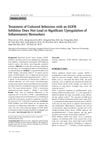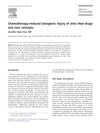Cutaneous Side Effects in Non-Small Cell Lung Cancer Patients Treated with Iressa (ZD1839), an Inhibitor of Epidermal Growth Factor
December 2003
in “
Acta Dermato Venereologica
”
The study reported on the cutaneous side effects of Iressa (ZD1839), an anti-cancer agent used in non-small cell lung cancer patients that inhibited epidermal growth factor receptor signal transduction. The most common side effect was acneiform eruptions on the face, trunk, and back (39%), followed by xerosis or desquamation affecting various body parts (36%). Other side effects included paronychial inflammation (6%), small ulcers in mucosal areas, and urticaria. These effects were similar to those of other agents targeting epidermal growth factor receptors, resulting from interference with skin signaling functions. The acne was linked to follicular changes and inflammation, while xerosis was due to disrupted epidermal proliferation and differentiation. The cause of paronychia and ingrown nails remained unclear.





